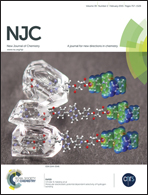Dynamical insights into the differential characteristics of Mycobacterium avium subsp. paratuberculosis peptide binding to HLA-DRB1 proteins associated with multiple sclerosis†
Abstract
Mycobacterium avium subsp. paratuberculosis (MAP) infections have been recently linked to multiple sclerosis in Sardinian population, with an amino acid sequence 301–309 of MAP2694 protein possessing a high antigenic potential. Peptide presentation by HLA protein is an important step in adaptive immune response to pathogens, which is linked to the stable peptide–HLA complex. In this study we focus on two predisposing (*15:01, *03:01) and two protective (*16:01, *15:02) HLA-DRB1 proteins in Sardinian population. We investigate in detail their binding characteristics to the MAP2694-derived peptide, with the aim of linking disease susceptibility to protein structural-dynamical features and ultimately to molecular mechanisms contributing to the disease. Using dihedral angle principal component analysis, we observe distinct chemical configurations and dynamics of the HLA peptide binding, between the predisposing and protective proteins upon binding. The difference persists in the collective motion of residues near the amino-terminal region of the peptide-binding groove involving polymorphic HLA-DRB1 residue 86. Buried surface area and binding energy estimations also support the protein distinction, suggesting preferential peptide binding towards the predisposing proteins. Finally, water dynamics analysis in the binding groove highlighted the role of slow water molecules in bridging H-bond interactions between the protein and peptide residues. Our work demonstrates the ability of molecular simulations to characterize MAP peptide binding to the proteins associated with multiple sclerosis in Sardinian population. Overall, this distinction between the predisposing and protective proteins can be associated with a biological mechanism that functionally contributes to disease onset in predisposed individuals.


 Please wait while we load your content...
Please wait while we load your content...